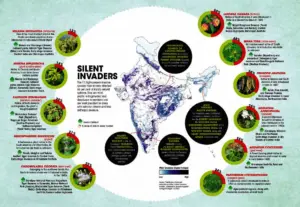
Why in news?
- Invasive alien species (IAS) have emerged as a major concern in recent years, posing a significant threat to India’s rich biodiversity, ecological balance, and economic well-being.
- From the fragile ecosystems of the Andaman and Nicobar Islands to agricultural heartlands, these unwelcome guests are disrupting natural order and causing widespread damage.
Understanding Invasive Alien Species
- Invasive Alien Species are organisms – plants, animals, pathogens, and others – introduced outside their natural habitat.
- Unlike domesticated or naturalized species, IAS lack natural predators or competitors in their new environment, allowing them to reproduce rapidly and dominate native species for resources.
- This aggressive behavior disrupts food chains, alters ecosystem functions, and ultimately leads to biodiversity loss.
- The Convention on Biological Diversity (CBD) defines IAS based on their ability to “arrive, survive, and thrive” in their new environment. India’s Wildlife Protection Act (1972, amended 2022) echoes this definition, classifying IAS as non-native species posing a threat to wildlife or habitats.
The Ripple Effect: Impacts of Invasive Alien Species
- The consequences of IAS are far-reaching. They can:
- Cause decline or extinction of native species:
- Through competition, predation, or disease transmission, IAS can push native flora and fauna towards endangerment or even extinction.
- Studies show that 1 in 10 species on the IUCN Red List are threatened by IAS.
- Disrupt ecosystems:
- Invasive species disrupt delicate ecosystem balances, impacting food chains and altering the way ecosystems function.
- This can lead to habitat loss and a decline in ecosystem services that benefit humans.
- Hinder livelihoods:
- Agriculture, forestry, and fisheries are crucial income sources in India.
- IAS can significantly damage crops, reduce fish stocks, and harm forests, impacting livelihoods, particularly in rural communities.
- Cause decline or extinction of native species:
Examples of Invasive Alien Species in India
- Wildlife:
- African catfish, Nile tilapia, red-bellied piranha, and alligator gar are some invasive fish species wreaking havoc on native ecosystems.
- The red-eared slider, a popular pet turtle, is another example, outcompeting native turtles for resources.
- Plants:
- Lantana camara, Chromolaena odorata, Prosopis juliflora, and Parthenium hysterophorus are some invasive plants displacing native vegetation and impacting agricultural lands.
A Case in Point: Keoladeo National Park
- The story of Keoladeo National Park in Rajasthan exemplifies the devastating impact of IAS.
- African catfish, introduced into the park, prey on waterfowl and migratory birds, altering the park’s food chain and ecological balance.
The Global Fight Against Invasive Alien Species
- Recognizing the global threat posed by IAS, international efforts are underway to manage and mitigate their impact.
- The Convention on Biological Diversity (CBD) plays a key role, urging member states to prevent the introduction of harmful species and control established populations.
- The recently adopted Kunming-Montreal Global Biodiversity Framework sets an ambitious target – a 50% reduction in the impact of IAS on biodiversity and ecosystems by 2030.
- Additionally, organizations like the IUCN Invasive Species Specialist Group (ISSG) provide vital information and resources to support international efforts.
India’s Initiatives
- India is actively addressing the IAS challenge through various initiatives:
- National Biodiversity Action Plan: Target 4 of this plan explicitly focuses on preventing and managing invasive species.
- National Action Plan on Invasive Alien Species (NAPINVAS): This plan launched by the Ministry of Environment, Forest and Climate Change (MoEFCC) prioritizes preventing new introductions, early detection, and control of established IAS populations.
- National Invasive Species Information Center (NISIC): This center serves as a resource hub, raising awareness and providing information on IAS in India.
- Plant Quarantine (Regulation of Import into India) Order, 2003: This regulation aims to prevent the introduction of IAS by regulating the import of plants and plant materials.
Conclusion
- Combating the threat of IAS requires a multi-pronged approach. Public awareness campaigns, stricter biosecurity measures, early detection programs, and effective eradication strategies are crucial. Additionally, promoting research on IAS management and fostering international collaboration are essential steps.
- By taking decisive action and working together, we can mitigate the impact of invasive alien species and safeguard India’s precious biodiversity for generations to come.
People also ask
Q1: What are Invasive Alien Species (IAS)?
Ans: IAS are plants, animals, pathogens, or other organisms introduced outside their natural habitat that can harm native species, ecosystems, and human well-being. Unlike pets or agricultural crops, IAS lack natural controls in their new environment, allowing them to reproduce rapidly and disrupt the ecological balance.
Q2: How do IAS harm India?
Ans: IAS harm India by squeezing out native plants and animals, messing up ecosystems, and hurting agriculture, fishing, and forestry.
I don’t think the title of your article matches the content lol. Just kidding, mainly because I had some doubts after reading the article.